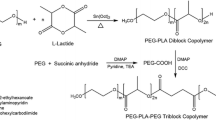ABSTRACT
Purpose
To develop block copolymer micelles as an aqueous dosage form for a potent glycolytic enzyme inhibitor, 3-(3-pyridinyl)-1-(4-pyridinyl)-2-propen-1-one (3PO).
Methods
The micelles were prepared from poly(ethylene glycol)-poly(aspartate hydrazide) [PEG-p(HYD)] block copolymers to which 3PO was conjugated through an acid-labile hydrazone bond. The optimal micelle formulation was determined following the screening of block copolymer library modified with various aromatic and aliphatic pendant groups. Both physical drug entrapment and chemical drug conjugation methods were tested to maximize 3PO loading in the micelles during the screening.
Results
Particulate characterization showed that the PEG-p(HYD) block copolymers conjugated with 3PO (2.08∼2.21 wt.%) appeared the optimal polymer micelles. Block copolymer compositions greatly affected the micelle size, which was 38 nm and 259 nm when 5 kDa and 12 kDa PEG chains were used, respectively. 3PO release from the micelles was accelerated at pH 5.0, potentiating effective drug release in acidic tumor environments. The micelles retained biological activity of 3PO, inhibiting various cancer cells (Jurkat, He-La and LLC) in concentration ranges similar to free 3PO.
Conclusion
A novel micelle formulation for controlled delivery of 3PO was successfully prepared.






Similar content being viewed by others
REFERENCES
Berdanier CD. Drugs, nutrients, and hormones in mitochondrial function. Oxid Stress Dis. 2005;16:455–506.
Vizan P, Boros LG, Figueras A, Capella G, Mangues R, Bassilian S, et al. K-ras codon-specific mutations produce distinctive metabolic phenotypes in human fibroblasts. Cancer Res. 2005;65:5512–5.
Hue L, Rousseau GG. Fructose-2,6-bisphosphate and the control of glycolysis by growth-factors, tumor promoters and oncogenes. Adv Enzyme Regul. 1993;33:97–110.
Ramanathan A, Wang C, Schreiber SL. Perturbational profiling of a cell-line model of tumorigenesis by using metabolic measurements. Proc Natl Acad Sci. 2005;102:5992–7.
Mazurek S, Zwerschke W, Jansen-Durr P, Eigenbrodt E. Metabolic cooperation between different oncogenes during cell transformation: interaction between activated ras and hpv-16 e7. Oncogene. 2001;20:6891–8.
Telang S, Yalcin A, Clem AL, Bucala R, Lane AN, Eaton JW, et al. Ras transformation requires metabolic control by 6-phosphofructo-2-kinase. Oncogene. 2006;25:7225–34.
Clem B, Telang S, Clem A, Yalcin A, Meier J, Simmons A, et al. Small-molecule inhibition of 6-phosphofructo-2-kinase activity suppresses glycolytic flux and tumor growth. Mol Cancer Ther. 2008;7:110–20.
Cukierman E, Khan DR. The benefits and challenges associated with the use of drug delivery systems in cancer therapy. Biochem Pharmacol. 2010;80:762–70.
Matsumura Y, Kataoka K. Preclinical and clinical studies of anticancer agent-incorporating polymer micelles. Cancer Sci. 2009;100:572–9.
Kataoka K, Kwon GS, Yokoyama M, Okano T, Sakurai Y. Block-copolymer micelles as vehicles for drug delivery. J Control Release. 1993;24:119–32.
Kwon GS, Yokoyama M, Okano T, Sakurai Y, Kataoka K. Biodistribution of micelle-forming polymer-drug conjugates. Pharm Res. 1993;10:970–4.
Kwon GS, Naito M, Kataoka K, Yokoyama M, Sakurai Y, Okano T. Block copolymer micelles as vehicles for hydrophobic drugs. Colloids Surf B Biointerfaces. 1994;2:429–34.
Matsumura Y. Poly (amino acid) micelle nanocarriers in preclinical and clinical studies. Adv Drug Deliv Rev. 2008;60:899–914.
Kataoka K, Harada A, Nagasaki Y. Block copolymer micelles for drug delivery: design, characterization and biological significance. Adv Drug Deliv Rev. 2001;47:113–31.
Yokoyama M, Kwon GS, Okano T, Sakurai Y, Naito M, Kataoka K. Influencing factors on in-vitro micelle stability of adriamycin-block copolymer conjugates. J Control Release. 1994;28:59–65.
Gao ZS, Eisenberg A. A model of micellization for block-copolymers in solutions. Macromolecules. 1993;26:7353–60.
Allen C, Maysinger D, Eisenberg A. Nano-engineering block copolymer aggregates for drug delivery. Colloid Surf B. 1999;16:3–27.
West KR, Otto S. Reversible covalent chemistry in drug delivery. Curr Drug Discov Technol. 2005;2:123–60.
Cammas S, Kataoka K. Functional poly[(ethylene oxide)-co-(beta-benzyl-l-aspartate)] polymeric micelles—block-copolymer synthesis and micelles formation. Macromol Chem Phys. 1995;196:1899–905.
Lavasanifar A, Samuel J, Kwon GS. Poly(ethylene oxide)-block-poly(l-amino acid) micelles for drug delivery. Adv Drug Deliv Rev. 2002;54:169–90.
Lee HJ, Ponta A, Bae Y. Polymer nanoassemblies for cancer treatment and imaging. Ther Deliv. 2010;1:803–17.
Bae Y, Jang WD, Nishiyama N, Fukushima S, Kataoka K. Multifunctional polymeric micelles with folate-mediated cancer cell targeting and ph-triggered drug releasing properties for active intracellular drug delivery. Mol Biosyst. 2005;1:242–50.
Bae Y, Kataoka K. Intelligent polymeric micelles from functional poly(ethylene glycol)-poly(amino acid) block copolymers. Adv Drug Deliv Rev. 2009;61:768–84.
Jones AT, Gumbleton M, Duncan R. Understanding endocytic pathways and intracellular trafficking: a prerequisite for effective design of advanced drug delivery systems. Adv Drug Deliv Rev. 2003;55:1353–7.
Vander Heiden MG, Thompson CB, Cantley LC. Understanding the warburg effect: the metabolic requirements of cell proliferation. Science. 2009;324:1029–33.
Gillies RJ, Robey I, Gatenby RA. Causes and consequences of increased glucose metabolism of cancers. J Nucl Med. 2008;49:24s–42s.
Yokoyama M, Kwon GS, Okano T, Sakurai Y, Seto T, Kataoka K. Preparation of micelle-forming polymer-drug conjugates. Bioconjugate Chem. 1992;3:295–301.
Ponta A, Bae Y. Peg-poly(amino acid) block copolymer micelles for tunable drug release. Pharm Res. 2010;27:2330–42.
Jain RK. Delivery of molecular and cellular medicine to solid tumors. Adv Drug Deliv Rev. 1997;26:71–90.
Wexler EJ, Gravallese EM, Czerniak PM, Devenny JJ, Longtine J, Wong MK, et al. Tumor biology: use of tiled images in conjunction with measurements of cellular proliferation and death in response to drug treatments. Clin Cancer Res. 2000;6:3361–70.
Bae Y, Nishiyama N, Fukushima S, Koyama H, Matsumura Y, Kataoka K. Preparation and biological characterization of polymeric micelle drug carriers with intracellular ph-triggered drug release property: tumor permeability, controlled subcellular drug distribution, and enhanced in vivo antitumor efficacy. Bioconjugate Chem. 2005;16:122–30.
Kataoka K, Matsumoto T, Yokoyama M, Okano T, Sakurai Y, Fukushima S, et al. Doxorubicin-loaded poly(ethylene glycol)-poly(beta-benzyl-l-aspartate) copolymer micelles: their pharmaceutical characteristics and biological significance. J Control Release. 2000;64:143–53.
Suzuki H, Nakai D, Seita T, Sugiyama Y. Design of a drug delivery system for targeting based on pharmacokinetic consideration. Adv Drug Deliv Rev. 1996;19:335–57.
Takakura Y, Hashida M. Macromolecular carrier systems for targeted drug delivery: pharmacokinetic considerations on biodistribution. Pharm Res. 1996;13:820–31.
ACKNOWLEDGMENTS & DISCLOSURES
This research is supported by the Kentucky Lung Cancer Research Program.
Author information
Authors and Affiliations
Corresponding author
Rights and permissions
About this article
Cite this article
Akter, S., Clem, B.F., Lee, H.J. et al. Block Copolymer Micelles for Controlled Delivery of Glycolytic Enzyme Inhibitors. Pharm Res 29, 847–855 (2012). https://doi.org/10.1007/s11095-011-0613-4
Received:
Accepted:
Published:
Issue Date:
DOI: https://doi.org/10.1007/s11095-011-0613-4




